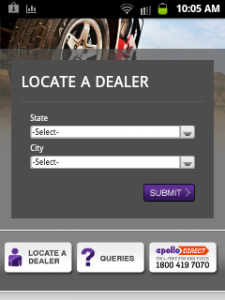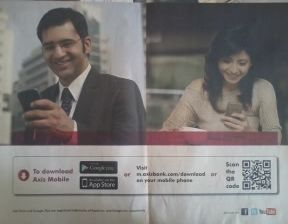Of late, there has been a marked increase in QR codes conforming with the basic guidelines of how to make QR codes work. As a result, close to 50% of QR codes we’ve come across in the last 2-3 months work – as in they can be scanned successfully from a variety of smartphones.
For a quick recap, QR codes enable smartphone users to scan a single code and visit websites and landing pages, download mobile apps, add contact info from business cards to their phonebooks, and lots more – without the hassles of typing large chunks of text on the virtual keyboards of their smartphones.
Now that scannability of QR codes seems to have reached a tipping point, let’s turn our attention to what happens next – that is, to people who’ve found enough reason to scan the codes in the first place. As marketers will agree, the CTA (Call To Action) that follows is really the crux of the QR code based campaign.
Let’s illustrate a few CTA best practices by using the following examples.
 3M. By scanning the QR code in the ad, readers can “Like” the Facebook page of 3M’s recent “Car Care” offering with a single tap. We love this example since it represents a very simple and cost-effective way by which a company can stay in touch with potential customers who might be interested in its new product or service but are not yet ready to buy – i.e. “nurture a lead”, as we call it in B2B marketing. This is the type of smart responses for which we advocate the use of our QR360 SmartResponse codes. To understand the power of staying in touch or, per contra, the danger of losing contact, let’s take this example of a new packaged tour operator that advertised heavily in newspapers a couple of months ago. In an opaque industry that’s replete with horror stories of hidden costs, this startup stood out with its tagline “all inclusive price, no conditions apply”. Its message was very appealing and we decided to contact this company when it was time for us to book a holiday package. We’ve reached that point now. However, we’re not able to recall the name of the firm! Lost business!! If only this tour operator had used QR360 in the 3M-like fashion, it would’ve bid for our business by staying on our radar via our Facebook newsfeed, the way 3M Care Care does.
3M. By scanning the QR code in the ad, readers can “Like” the Facebook page of 3M’s recent “Car Care” offering with a single tap. We love this example since it represents a very simple and cost-effective way by which a company can stay in touch with potential customers who might be interested in its new product or service but are not yet ready to buy – i.e. “nurture a lead”, as we call it in B2B marketing. This is the type of smart responses for which we advocate the use of our QR360 SmartResponse codes. To understand the power of staying in touch or, per contra, the danger of losing contact, let’s take this example of a new packaged tour operator that advertised heavily in newspapers a couple of months ago. In an opaque industry that’s replete with horror stories of hidden costs, this startup stood out with its tagline “all inclusive price, no conditions apply”. Its message was very appealing and we decided to contact this company when it was time for us to book a holiday package. We’ve reached that point now. However, we’re not able to recall the name of the firm! Lost business!! If only this tour operator had used QR360 in the 3M-like fashion, it would’ve bid for our business by staying on our radar via our Facebook newsfeed, the way 3M Care Care does.
APOLLO TYRES. Scanning the QR code takes the reader to a dedicated microsite on the advertised theme “You First”, rather than landing the reader on its home page and potentially losing him or her amidst the clutter of other things featured there. Update: The microsite is also mobile-optimized, which is another great thing. One tip: Using LBS technology, it’s possible to auto-fetch the City and State fields in the “LOCATE A DEALER” screen instead of asking the user to enter them manually.
 AXIS BANK. Most ads for mobile apps available on multiple operating systems provide multiple QR codes, one each for each OS version. While this sounds logical, this approach suffers from a fatal flaw, as we can see from this Pune Mirror ad. It displays three QR codes, one each for the iOS, Android and Windows Phone versions of the “Car Unblocked” app. To fit them all within the space that’s allotted only for one code, the advertiser has had to resize them to below the recommended size (1″ x 1″). Ergo, these QR codes are not prominently visible and anyway fail to scan for people who manage to spot it. As a result, the ad goes waste. In contrast, Axis Bank uses a single QR code to promote all OS versions of its mobile banking app. This QR code automatically routes the user to the app store of the respective OS from where the corresponding version of the app can be downloaded with a single tap. If you lack the technical skills to develop the so-called omnicode version of QR code used in this ad, please feel free to contact us.
AXIS BANK. Most ads for mobile apps available on multiple operating systems provide multiple QR codes, one each for each OS version. While this sounds logical, this approach suffers from a fatal flaw, as we can see from this Pune Mirror ad. It displays three QR codes, one each for the iOS, Android and Windows Phone versions of the “Car Unblocked” app. To fit them all within the space that’s allotted only for one code, the advertiser has had to resize them to below the recommended size (1″ x 1″). Ergo, these QR codes are not prominently visible and anyway fail to scan for people who manage to spot it. As a result, the ad goes waste. In contrast, Axis Bank uses a single QR code to promote all OS versions of its mobile banking app. This QR code automatically routes the user to the app store of the respective OS from where the corresponding version of the app can be downloaded with a single tap. If you lack the technical skills to develop the so-called omnicode version of QR code used in this ad, please feel free to contact us.
We’ll continue our coverage of QR code based CTA best practices in Part-2 of this post, which will be published by 6 January 2013. Watch this space!